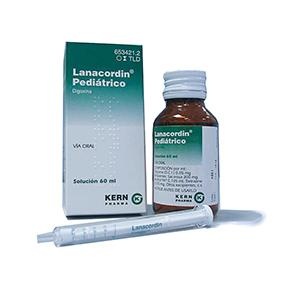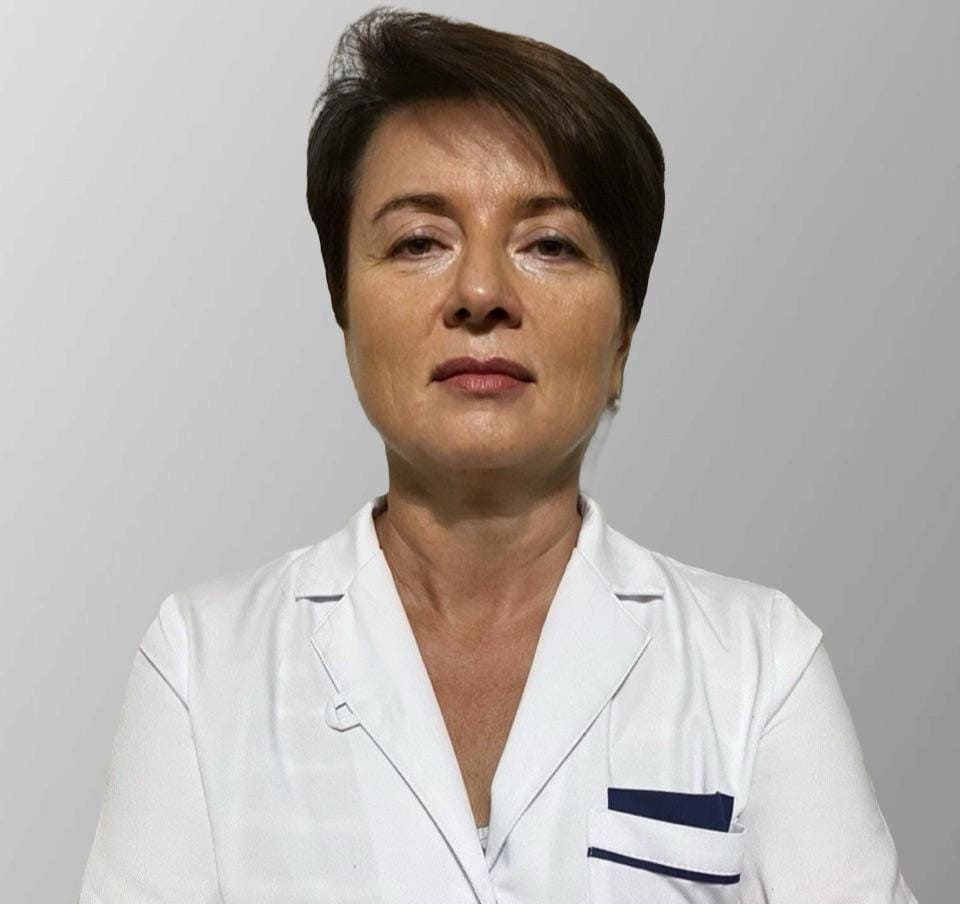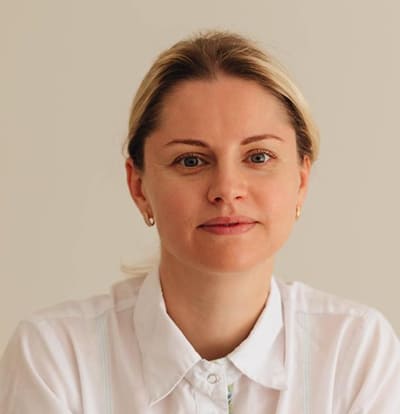

LANACORDIN PEDIATRICO

Ask a doctor about a prescription for LANACORDIN PEDIATRICO

How to use LANACORDIN PEDIATRICO
Introduction
Package Leaflet: Information for the User
Lanacordin Pediatric 0.05 mg/ml Oral Solution
Digoxin
Read the entire package leaflet carefully before starting to use the medicine, as it contains important information for you.
- Keep this package leaflet, as you may need to read it again.
- If you have any questions, consult your doctor or pharmacist.
- This medicine has been prescribed to you only, and you should not give it to others, even if they have the same symptoms as you, as it may harm them.
- If you experience side effects, consult your doctor or pharmacist, even if they are not listed in this package leaflet.
Contents of the Package Leaflet:
- What is Lanacordin Pediatric and what is it used for
- What you need to know before taking Lanacordin Pediatric
- How to take Lanacordin Pediatric
- Possible side effects
- Storage of Lanacordin Pediatric
- Package contents and additional information
1. What is Lanacordin Pediatric and what is it used for
Lanacordin Pediatric belongs to a group of medicines called cardiac glycosides. Its active ingredient is digoxin, which increases the strength of the heart muscle's contraction by specifically inhibiting an enzyme called Na+/K+ dependent adenosine triphosphatase.
Lanacordin Pediatric is indicated for the treatment of certain heart problems, such as:
- "Chronic heart failure" where the main problem is "systolic dysfunction" (alterations in the heart's contraction).
- When heart failure is accompanied by "atrial fibrillation" (abnormal heart rhythm or frequency originating from the upper chambers of the heart).
- In the treatment of certain "supraventricular arrhythmias" (disorders of heart rate or rhythm originating from the upper chambers of the heart), especially atrial flutter and atrial fibrillation, with the main benefit being a reduction in ventricular rate (slower heart rate).
2. What you need to know before taking Lanacordin Pediatric
Do not use Lanacordin Pediatric
- If you are allergic (hypersensitive) to digoxin, other digitalis glycosides, or any of the other ingredients of Lanacordin Pediatric.
- If you have been told that you have any of the following heart problems:
- Intermittent cardiac block or second-degree atrioventricular block (alterations in the transmission of the electrical impulse between the upper and lower chambers of the heart), especially if you have a history of a heart condition called Stokes-Adams syndrome.
- Certain types of "supraventricular arrhythmias", such as Wolff-Parkinson-White syndrome (a hereditary heart disease).
- "Ventricular tachycardia" (rapid heartbeat originating from the ventricles) or "ventricular fibrillation" (very abnormal heart rhythm that can be fatal).
- "Hypertrophic cardiomyopathy" (a disease in which there is excessive growth of the heart muscle).
- If you have arrhythmias caused by poisoning with other cardiac glycosides (heart medicines).
- If you know or suspect that you have an accessory pathway (abnormal electrical communication between the atrium and ventricle) and you do not have a history of previous supraventricular arrhythmias, Lanacordin Pediatric is also contraindicated.
Warnings and precautions
This medicine should only be used under the supervision and control of a doctor. Consult your doctor before using this medicine in any of the following cases:
- If you have recently had a myocardial infarction, digoxin should be taken with caution, although it is not contraindicated in the immediate post-infarction period.
- If you are being treated with diuretics and an ACE inhibitor (heart and hypertension medicines), or only diuretics, as when digoxin administration is discontinued, your condition may worsen.
- If you have taken cardiac glycosides (heart medicines) two weeks before starting treatment with digoxin, your doctor should consider reducing the initial dose.
- If you are administered to elderly patients or patients with decreased renal function, the doctor should consider reducing both the initial and maintenance doses.
- When you are already being treated with digoxin, your doctor should periodically check your serum electrolytes and renal function (serum creatinine concentration). The frequency of these checks will depend on the severity of the case.
- If you have severe respiratory disease, as the heart muscle may be more sensitive to digoxin.
- If you have low potassium levels in your blood, as this makes the heart muscle more sensitive to the effects of digoxin.
- If you have hypoxia (low oxygen levels in the blood), hypomagnesemia (low magnesium levels in the blood), and marked hypercalcemia (high calcium levels in the blood), as these increase the sensitivity of the heart muscle to digoxin.
- If you have thyroid disease, you should be cautious when using Lanacordin Pediatric. The initial and maintenance doses of Lanacordin Pediatric should be reduced when thyroid function is deficient. In the case of hyperthyroidism (high levels of thyroid hormone in the blood), there is a relative resistance to digoxin (lower activity of this medicine), and the dose may need to be increased. During treatment of thyrotoxicosis (excess of thyroid hormones), the dose should be reduced as the disease is controlled.
- Patient with malabsorption syndrome (difficulty absorbing vitamins, minerals, and other nutrients from food) or gastrointestinal reconstructions may require higher doses of digoxin.
Using Lanacordin Pediatric with other medicines
Tell your doctor or pharmacist if you are using or have recently used other medicines, including those obtained without a prescription.
Digoxin blood levels may increase with the concomitant administration of the following medicines:
- Amiodarone, flecainide, prazosin, propafenone, quinidine, spironolactone (heart medicines).
- Diuretics (medicines to facilitate fluid elimination).
- Calcium channel blockers and ACE inhibitors (hypertension medicines).
- Erythromycin, tetracycline, gentamicin, itraconazole, trimethoprim (antibiotic medicines).
- Quinine (medicine for the treatment of malaria).
- Alprazolam, lithium salts (medicine for depression).
- Diphenoxylate with atropine (combination of medicines used as an antidiarrheal).
- Indomethacin, corticosteroids (anti-inflammatory medicines).
- Propantheline (medicine for the treatment of ulcers).
- Carbenoxolone (medicine for the treatment of mouth ulcers).
Digoxin blood levels may decrease with the concomitant administration of the following medicines:
- Antacids.
- Certain laxatives.
- Kaolin-pectin (antidiarrheal medicine).
- Neomycin, penicillamine, rifampicin (antibiotic medicines).
- Certain cytostatics (cancer treatment medicines).
- Metoclopramide (medicine for the treatment of vomiting).
- Sulfasalazine (anti-inflammatory medicine for the stomach).
- Adrenaline (a hormone).
- Salbutamol (medicine for the treatment of asthma).
- Colestyramine (medicine for the treatment of cholesterol).
- Phenytoin (medicine for the treatment of epilepsy).
Tell your doctor if you are taking a medicine that contains enzalutamide (for the treatment of prostate cancer). It may interfere with your digoxin tests.
Pregnancy and breastfeeding
Consult your doctor or pharmacist before using any medicine.
The use of digoxin is not contraindicated during pregnancy, although, as with all medicines, its use should only be considered when the expected clinical benefit to the mother outweighs any potential risk to the fetus.
Although digoxin passes into breast milk, the amounts are minimal, and breastfeeding is not contraindicated.
Driving and using machines
There is no data available on how Lanacordin Pediatric affects driving or using machines, so be careful not to perform tasks that require special attention until you know how you tolerate the medicine.
Lanacordin Pediatric contains sucrose
This medicine contains sucrose. If your doctor has told you that you have an intolerance to certain sugars, consult with them before taking this medicine.
Patient with diabetes mellitus should be aware that this medicine contains 0.16 g of glucose per ml. It may cause tooth decay.
Lanacordin Pediatric contains ethanol (alcohol)
This medicine contains 10% ethanol (alcohol), which corresponds to an amount of 0.1 mg per ml, equivalent to 2 ml of beer and 0.8 ml of wine.
This medicine is harmful to people with alcoholism.
The alcohol content should be taken into account in the case of pregnant or breastfeeding women, children, and high-risk groups, such as patients with liver disease or epilepsy.
Lanacordin Pediatric contains tartrazine
This medicine may cause allergic reactions because it contains tartrazine (E-102). It can cause asthma, especially in patients allergic to acetylsalicylic acid.
3. How to use Lanacordin Pediatric
Follow the administration instructions for Lanacordin Pediatric exactly as indicated by your doctor. Consult your doctor or pharmacist if you have any doubts.
The dose of Lanacordin Pediatric for each patient should be established individually according to age, body weight, and renal function. The suggested doses are only intended to serve as an initial guide.
Your doctor should take into account the difference in effects between the administration of digoxin in oral and injectable forms when changing from one pharmaceutical form to another. For example, if a patient is switched from the oral formulation to the intravenous formulation, the dose should be reduced by at least 33%.
Lanacordin Pediatric is supplied with a graduated pipette that should be used to measure all doses.
The normal dose is:
Adults and children over 10 years:
Loading dose (initial dose):
- Rapid oral administration:
750 to 1500 micrograms (0.75 to 1.5 mg) as a single dose.
- Slow oral administration:
250 to 750 micrograms (0.25 to 0.75 mg) should be administered daily for 1 week.
Maintenance dose:
Your doctor will indicate what your maintenance dose is, depending on your response to the initial treatment with Lanacordin Pediatric.
On average, most patients will be maintained on 125 to 750 micrograms (0.125 to 0.75 mg) of digoxin per day. However, in those who show greater sensitivity to adverse reactions to digoxin, a dose of 62.5 micrograms (0.0625 mg) per day or lower may be sufficient.
Newborns, infants, and children under 10 years (if they have not received cardiac glycosides in the preceding two weeks):
- Oral loading dose:
The doses in children depend on their weight.
However, these doses are between 25 and 45 micrograms over 24 hours.
The loading dose should be administered in divided doses, with approximately half of the total dose given as the first dose and additional fractions of the total dose administered at intervals of 4 to 8 hours, evaluating the clinical response before administering each additional dose.
- Maintenance dose:
Your doctor will indicate what the maintenance dose is, depending on the child's response to the initial treatment with Lanacordin Pediatric.
On average, most patients will be maintained between 20% and 25% of the loading dose, administered every 24 hours.
If you use more Lanacordin Pediatric than you should
If you have used more Lanacordin Pediatric than you should, consult your doctor, pharmacist, or call the Toxicology Information Service, telephone 91 562 04 20, indicating the medicine and the amount taken.
If you forget to use Lanacordin Pediatric
Do not use a double dose to make up for forgotten doses.
If you have any other questions about the use of this product, ask your doctor or pharmacist.
4. Possible side effects
Like all medicines, Lanacordin Pediatric can cause side effects, although not everyone gets them.
In general, adverse reactions to digoxin depend on the dose and occur at higher doses than those required to achieve a therapeutic effect. Consequently, adverse reactions are less common when digoxin is used within the recommended dose range or within the therapeutic concentration range in serum and careful attention is paid to the conditions and medication administered concurrently.
Cardiac disorders:
Cardiac arrhythmias and alterations in the electrical conduction of the heart, including:
- Ventricular contractions that precede the normal heart rhythm and may evolve into bigeminism (alteration of the heart rhythm in which normal heartbeats alternate with premature beats) or even trigeminism (alteration of the heart rhythm in which two normal heartbeats alternate with a premature beat).
- Atrial tachycardias (disorder of heart rhythm, such as rapid heartbeats originating from the upper chambers of the heart). It is common for them to be accompanied by atrioventricular block (disorder in the electrical conduction between the atria and ventricles) and not always a rapid pulse (see section 2. What you need to know before using Lanacordin Pediatric).
- Alterations in the electrocardiogram result.
- Sinus bradycardia (disorder that produces a decrease in heart rate). Especially in children, it can be a sign of digoxin intoxication.
- In children, the use of digoxin can produce any type of arrhythmia. The most common are alterations in the conduction of the electrical impulse or supraventricular tachyarrhythmias (disorders of heart rhythm not originating from the ventricles).
Gastrointestinal disorders:
Anorexia, nausea, and vomiting that disappear a few hours after taking the medicine. Diarrhea may also appear.
Digoxin administered orally has also been associated with intestinal ischemia (interruption of blood supply to the intestine) and, rarely, intestinal necrosis (death of part of the intestine due to interruption of blood supply).
Disorders of the reproductive system and breast:
Gynecomastia (development of breast tissue in a male) may occur with long-term administration.
Nervous system disorders:
Weakness, apathy, fatigue, malaise, headache, vision changes, depression, and even psychosis have been reported.
Skin and subcutaneous tissue disorders:
Urticaria-like or scarlatiform rash (generalized redness of the skin with small raised lesions).
Blood and lymphatic system disorders:
Marked eosinophilia (increase in the number of white blood cells in the blood).
Thrombocytopenia (decrease in the number of platelets in the blood).
If you experience side effects, consult your doctor or pharmacist, even if they are not listed in this package leaflet.
5. Storage of Lanacordin Pediatric
Keep out of sight and reach of children.
Store below 30°C.
Do not use this medicine after the expiration date stated on the packaging after "EXP". The expiration date is the last day of the month indicated.
Medicines should not be disposed of via wastewater or household waste. Place the packaging and any unused medicines in the SIGRE collection point at the pharmacy. If in doubt, ask your pharmacist how to dispose of the packaging and any unused medicines. This will help protect the environment.
6. Container Content and Additional Information
Composition of Lanacordin Pediatric
- The active ingredient is digoxin. Lanacordin Pediatric contains 0.05 mg of digoxin per ml of solution.
- The other components are sucrose, ethanol, tartrazine, anhydrous sodium phosphate, citric acid, methyl hydroxybenzoate, essential lime oil, propylene glycol, and purified water.
Appearance of the Product and Container Content
Oral solution. 60 ml container with a dosing syringe.
Marketing Authorization Holder and Manufacturer
Kern Pharma, S.L.
Polígono Ind. Colón II
Venus, 72
08228 Terrassa (Barcelona)
Spain
Date of the Last Review of this Prospectus:August 2025
Detailed and updated information on this medication is available on the website of the Spanish Agency for Medicines and Health Products (AEMPS) http://www.aemps.gob.es/
This information is intended only for doctors or healthcare professionals
The greatest therapeutic benefit of digoxin is obtained in patients with ventricular dilation.
METHOD OF USE:
The intramuscular route is painful and is associated with muscle necrosis (death of cardiac muscle cells). This route cannot be recommended.
Rapid intravenous injection can cause vasoconstriction, producing hypertension and/or reduced coronary flow. Therefore, slow injection speed is important in hypertensive heart failure and acute myocardial infarction.
Adults and Children Over 10 Years:
Loading Dose (Initial Dose):
- Rapid Oral Administration:
750 to 1500 micrograms (0.75 to 1.5 mg) as a single dose.
In less urgent cases, or when there is a greater risk of toxicity, for example in elderly patients, the oral loading dose should be administered in divided doses every six hours, administering approximately half of the total dose in the first dose. The clinical response should be evaluated before administering each additional dose (see section 2 "What you need to know before starting to use...").
- Slow Oral Administration:
250 to 750 micrograms (0.25 to 0.75 mg) should be administered daily for 1 week, followed by an adequate maintenance dose. A clinical response should be observed within a week.
NOTE: The choice between a rapid or slow oral digitalization regimen will depend on the patient's clinical condition and the urgency of the clinical indication.
Maintenance Dose:
Your doctor will indicate what your maintenance dose is, depending on the response to initial treatment with Lanacordín Pediatric.
On average, most patients will be maintained on 125 to 750 micrograms (0.125 to 0.75 mg) of digoxin per day. However, in those who show greater sensitivity to digoxin's adverse reactions, a dose of 62.5 micrograms (0.0625 mg) per day or lower may be sufficient.
The maintenance dose should be based on the percentage of body reserves lost each day due to elimination. The following formula has had widespread clinical use:
Maintenance Dose = Maximum Body Reserves x Daily Loss (percentage)
100
Where:
- Maximum Body Reserves = Loading Dose
Daily Loss (percentage) = 14 + creatinine clearance (Ccr) / 5
- Ccr is the creatinine clearance corrected based on a body weight of 70 kg or 1.73 m2 of body surface area. If only serum creatinine concentrations (Scr) are available, a Ccr (corrected based on a body weight of 70 kg) can be estimated in men as:
Ccr = (140 - age)
Scr (in mg/100 ml)
NOTE: When serum creatinine values are obtained in micromol/l, they can be converted to mg/100 ml (mg%) as follows:
Scr (mg/100 ml) = Scr (micromol/l) x 113.12
10,000
= Scr (micromol/l)
88.4
- Where 113.12 is the molecular weight of creatinine.
- In women, this result should be multiplied by 0.85.
- These formulas cannot be used for creatinine clearance in children.
In practice, this means that most patients will be maintained on 125 to 750 micrograms (0.125 to 0.75 mg) of digoxin per day. However, in those who show greater sensitivity to digoxin's adverse reactions, a dose of 62.5 micrograms (0.0625 mg) per day or lower may be sufficient.
Newborns, Infants, and Children Under 10 Years (if they have not received cardiac glycosides in the preceding two weeks):
- Oral Loading Dose:
The doses in children depend on their weight.
However, these doses are between 25 and 45 micrograms over 24 hours.
The loading dose should be administered in divided doses, with approximately half of the total dose given as the first dose and the additional fractions of the total dose at intervals of 4 to 8 hours, evaluating the clinical response before administering each additional dose.
- Maintenance:
Your doctor will indicate what the maintenance dose is, depending on the child's response to initial treatment with Lanacordín Pediatric.
On average, most patients will be maintained between 20% and 25% of the loading dose, administered every 24 hours.
In newborns, especially premature infants, the renal clearance of digoxin is decreased, and appropriate dose reductions should be considered, beyond the general dosing instructions.
After the newborn phase, children generally require proportionally higher doses than adults based on weight or body surface area, as indicated in the following table. Children over 10 years require adult doses proportional to their body weight.
- Oral Loading Dose:
This should be administered according to the following program:
Premature newborns <1.5 kg: 25 micrograms/kg over 24 hours.
Premature newborns 1.5 kg - 2.5 kg: 30 micrograms/kg over 24 hours.
Full-term newborns up to 2 years: 45 micrograms/kg over 24 hours.
2 to 5 years: 35 micrograms/kg over 24 hours.
5 to 10 years: 25 micrograms/kg over 24 hours.
The loading dose should be administered in divided doses, with approximately half of the total dose given as the first dose and the additional fractions of the total dose at intervals of 4 to 8 hours, evaluating the clinical response before administering each additional dose.
- Maintenance:
The maintenance dose should be administered according to the following program:
Premature newborns:
- daily dose = 20% of the 24-hour loading dose (intravenous or oral).
Full-term newborns and children up to 10 years:
- daily dose = 25% of the 24-hour loading dose (intravenous or oral).
These dosing regimens are designed to be a guideline, and careful clinical observation and monitoring of digoxin serum levels (see Monitoring) should be performed to adjust the dose in these pediatric patient groups.
If cardiac glycosides have been administered in the two weeks prior to starting treatment with Lanacordin Pediatric, it should be anticipated that the optimal loading doses of Lanacordin will be lower than those recommended above.
Digitalis glycosides are a significant cause of accidental poisoning in children. The tolerance of newborns to digitalis glycosides is variable since the renal clearance of the medication is reduced. Premature and immature newborns are especially sensitive.
Elderly Patients:
The tendency towards altered renal function and low net body mass in elderly patients influences the pharmacokinetics of Lanacordin Pediatric, such that elevated digoxin serum levels and associated toxicity may easily appear, unless lower doses of Lanacordin are used than those used in non-elderly patients. Digoxin serum levels should be regularly monitored, and hypokalemia should be avoided.
Dosing Recommendations in Specific Patient Groups:
See the "Warnings and Precautions" section.
Monitoring:
Digoxin serum concentrations can be expressed in conventional units of ng/ml or in SI units of nmol/l. To convert ng/ml to nmol/l, multiply ng/ml by 1.28.
The serum concentration of digoxin can be determined by radioimmunoassay. Blood should be drawn 6 hours or more after the last dose of Lanacordin Pediatric. There are no strict guidelines on the interval of serum concentrations that are most effective, but most patients will benefit, with minimal risk of developing signs and symptoms of toxicity, with digoxin concentrations between 0.8 ng/ml (1.02 nmol/l) and 2.0 ng/ml (2.56 nmol/l). Above this range, signs and symptoms of toxicity may be more frequent, and levels above 3.0 ng/ml (3.84 nmol/l) are likely to be toxic. However, to decide if a patient's symptoms are due to digoxin, the clinical condition, along with the serum potassium level and thyroid function, are important factors to consider.
Other glycosides, including digoxin metabolites, may interfere with available assays, so caution should be exercised with values that do not seem to be in line with the patient's clinical condition.
SYMPTOMS OF OVERDOSAGE AND TREATMENT:
Adults:
In adults without heart disease, clinical observation indicates that a digoxin overdose of 10-15 mg was the dose that led to death in half of the patients. If an adult without heart disease ingested more than 25 mg of digoxin, death or progressive toxicity that would only respond to the administration of digoxin-specific antibody fragments would occur.
Children:
In children from 1 to 3 years without heart disease, clinical observation suggests that a digoxin overdose of 6 to 10 mg was the dose that led to death in half of the patients. If more than 10 mg of digoxin were ingested by a child from 1 to 3 years without heart disease, the outcome would invariably be fatal if digoxin-specific antibody fragments were not administered.
After recent ingestion, either by accident or deliberate self-poisoning, the available load for absorption could be reduced by gastric lavage.
In cases of massive digitalis ingestion, patients should receive large doses of activated charcoal to prevent absorption and to bind digoxin in the intestine during enteroenteric recirculation.
If hypokalemia exists, it should be corrected with potassium supplements, either orally or intravenously, depending on the urgency of the situation. In cases where a large amount of Lanacordin Pediatric has been ingested, hyperkalemia may appear due to potassium release from skeletal muscle. Before administering potassium in cases of digoxin overdose, the serum potassium level should be known.
Bradyarrhythmias may respond to atropine, but temporary cardiac pacing may be required. Ventricular arrhythmias may respond to lignocaine (anesthesia medication) or phenytoin (epilepsy treatment medication).
Dialysis is not particularly effective for eliminating digoxin from the body in cases of life-threatening toxicity.
After the intravenous administration of digoxin-specific antibody fragments (of ovine origin), there is a rapid reversal of the complications associated with severe digoxin poisoning, digitoxin, and related glycosides.

How much does LANACORDIN PEDIATRICO cost in Spain ( 2025)?
The average price of LANACORDIN PEDIATRICO in December, 2025 is around 3.9 EUR. Prices may vary depending on the region, pharmacy, and whether a prescription is required. Always check with a local pharmacy or online source for the most accurate information.
- Country of registration
- Average pharmacy price3.9 EUR
- Active substance
- Prescription requiredYes
- Manufacturer
- This information is for reference only and does not constitute medical advice. Always consult a licensed doctor before taking any medication. Oladoctor is not responsible for medical decisions based on this content.
- Alternatives to LANACORDIN PEDIATRICODosage form: TABLET, 0.25 mgActive substance: digoxinManufacturer: Kern Pharma S.L.Prescription requiredDosage form: INJECTABLE, 0.25 mg digoxin/mlActive substance: digoxinManufacturer: Kern Pharma S.L.Prescription requiredDosage form: TABLET, 0.25 mgActive substance: digoxinManufacturer: Teofarma S.R.L.Prescription required
Alternatives to LANACORDIN PEDIATRICO in other countries
The best alternatives with the same active ingredient and therapeutic effect.
Alternative to LANACORDIN PEDIATRICO in Poland
Alternative to LANACORDIN PEDIATRICO in Ukraine
Online doctors for LANACORDIN PEDIATRICO
Discuss dosage, side effects, interactions, contraindications, and prescription renewal for LANACORDIN PEDIATRICO – subject to medical assessment and local rules.










